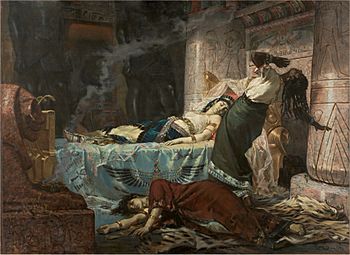The Death of Cleopatra facts for kids
Quick facts for kids The Death of Cleopatra |
|
|---|---|
| Spanish: La muerte de Cleopatra | |
 |
|
| Artist | Juan Luna |
| Year | 1881 |
| Medium | Oil on canvas |
| Dimensions | 250 cm × 340 cm (98.4 in × 132 in) |
| Location | Museo del Prado, Madrid |
The Death of Cleopatra is a famous painting from 1881. It was created by the Filipino artist Juan Luna. You can see it today at the Museo del Prado in Madrid, Spain.
The painting shows the final moments of Cleopatra, who was the last queen of Ancient Egypt. Juan Luna painted this artwork while he was living in Rome. It was his first time showing his art in a big exhibition. The painting won a silver medal at the 1881 National Exposition of Fine Arts in Madrid.
This painting is special for many reasons. It is one of only three artworks by Filipino artists at the Prado museum. It was painted when people in the Philippines were starting to feel more proud of their country. The Death of Cleopatra showed that Filipino artists, especially Luna, could be just as good as European artists.
Contents
What the Painting Shows
The Death of Cleopatra captures the scene right after Cleopatra has died. Luna got his ideas for the painting from Plutarch's stories about Cleopatra's life.
Cleopatra and Her Surroundings
Cleopatra's body is in the middle of the painting. She lies on a fancy bed with a golden headboard. The bedsheets are rich and have hieroglyphs (ancient Egyptian writing) on them. Cleopatra herself wears beautiful jewels and queenly clothes. Smoke from a nearby lamp, likely incense, floats above her. This smoke makes the scene feel mysterious and shows she has passed away.
Servants and the Asp
Two of Cleopatra's servants are also in the painting. The first servant, Iras, is already dead at Cleopatra's feet. The second servant, Charmion, is falling down. She has just adjusted Cleopatra's crown and will soon die too. The asp, a type of snake that supposedly caused Cleopatra's death, is barely visible. It is by the foot of a column, slithering away.
The Setting and Symbols
The room in the painting looks like a place for a funeral. There are many decorations that show this. You can see a sphinx (a mythical creature with a human head and a lion's body) by the foot of the bed. There are also canopic jars (containers used in ancient Egypt for organs) near the headboard. The lamp and the columns are decorated with hieroglyphs. In the background, there is a statue of Anubis, the Egyptian god of the dead. This statue hints at what is about to happen.
History of the Painting
Juan Luna started working on The Death of Cleopatra in his studio in Rome. He had moved to Rome in 1878 with his teacher, Alejo Vera.
Early Sketch and Sale
In 1880, Luna created a study or sketch (called a boceto) for the painting. This sketch was inspired by a 1874 painting of Cleopatra's death by French artist Jean-André Rixens. The boceto was sold in March 2019 for 9.3 million Philippine pesos.
Awards and Ownership
Because of the painting's success, Luna received a special scholarship from the Ayuntamiento de Manila. After the art competition, Luna sold the painting for 5,000 Spanish pesetas. This was a very high price for a painting at that time. The Spanish government later bought The Death of Cleopatra for one thousand duros. It was seen as Luna's "graduation work."
Recent Exhibitions
After being shown in 1887, the painting was not seen by the public for 130 years. It was finally displayed again in 2017 at the National Gallery of Singapore.
More Paintings by Juan Luna
- Spoliarium
- España y Filipinas
- Las Damas Romanas
- The Blood Compact
See also
 In Spanish: Cleopatra (Juan Luna) para niños
In Spanish: Cleopatra (Juan Luna) para niños

